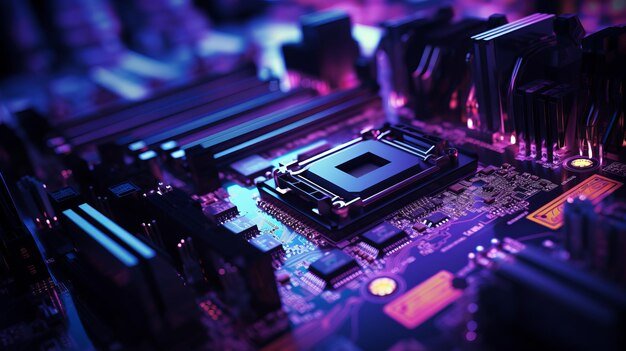
Building or upgrading a computer? Then understanding what a motherboard is becomes essential. It may be the least flashy part of your machine, but it acts like a control center. Think of it as the backbone that connects all other components. Without a good motherboard, even the fastest CPU can’t do much. So, let’s explore what makes a motherboard tick and how it impacts your computer’s performance.
What Is a Motherboard? An In-Depth Definition
A motherboard, often called the main board or mobo, is the large circuit board inside your computer. It ties everything together—CPU, memory, storage, graphics, and more. It’s designed to fit neatly inside the computer case and provides a platform for all hardware parts to work together. Imagine a city’s road map, but for your PC’s components. Without it, your computer would be a pile of disconnected parts.
Essential Components of a Motherboard
CPU Socket and Central Processing Unit (CPU)
The CPU socket is a special slot where the brain of your computer sits. This tiny chip handles calculations and runs programs. Different CPUs need specific sockets to work properly. Picking a compatible socket ensures your CPU fits and performs as expected.
Memory Slots and RAM
Memory slots, or DIMMs, hold RAM modules. RAM acts like your computer’s short-term memory, helping it run applications smoothly. Motherboards typically support various RAM types and capacities, impacting your machine’s speed and multitasking ability.
Expansion Slots (Bus Slots)
Expansion slots, mainly PCIe (Peripheral Component Interconnect Express) slots, let you add extra hardware. You can install graphics cards, sound cards, or network adapters here. These slots come in different sizes and speeds, depending on what you need.
Storage Connectors
Storage connectors link your motherboard to drives like SSDs or hard drives. SATA connectors are common and support many storage devices. Modern motherboards also feature M.2 slots, perfect for fast, compact SSDs. These increase storage speed and overall system responsiveness.
Chipsets and Architecture
Traditional Chipset: Northbridge and Southbridge
Older motherboards featured two main chips: the northbridge and southbridge. The northbridge managed communication between the CPU, RAM, and graphics. The southbridge handled peripherals like USB ports, storage, and sound. Data had to go through these chips for various functions.
Modern Architecture: Platform Controller Hub (PCH)
Today, most systems use a single chip called the platform controller hub (PCH). It replaces the traditional chips, offering better speed and less power consumption. Intel adopted this design to make motherboards more efficient and more reliable.
The Evolution of Motherboard Architecture
From Northbridge/Southbridge to PCH
Motherboard design has changed a lot over the years. The old northbridge and southbridge setup was common until the late 2000s. Now, the PCH system brings it all into one chip, making motherboards simpler and faster.
Benefits of Modern Architecture
With integrated design, data flows faster between components. Power use drops, and spare space increases. These improvements mean smoother gaming, faster data transfer, and longer-lasting hardware.
I/O Interfaces and Connectivity Features
Rear Input/Output Panel Overview
Most of your motherboard’s connectivity options are on the back panel. These ports allow you to connect peripherals like keyboards, mice, and monitors with ease. They’re the bridge between your PC and the outside world.
USB Ports
USB ports are everywhere – for keyboards, mice, cameras, external drives, and printers. Today’s motherboards support various USB types, including the quick USB 3.0 and the ultra-fast USB Type-C. Plus, they provide power to your devices, saving you from extra adapters.
Video Outputs and Integrated Graphics
Many motherboards come with built-in graphics, called integrated video. Older models sport DVI or VGA ports, while newer models include HDMI or DisplayPort. If you only browse or work with light applications, integrated graphics work fine. For gaming or editing, a dedicated graphics card is better.
Network Interface Cards
The Ethernet port (RJ-45 connector) lets your PC connect wired to the internet. This connection is usually more stable than Wi-Fi, ideal for gaming, streaming, or large downloads. Some motherboards include built-in Ethernet, while others might need an add-on card.
Audio Components
Most motherboards have a built-in sound card, providing decent audio quality for everyday use. If you’re an audiophile or into music production, a dedicated sound card can boost sound clarity and richness.
Motherboard Form Factors
ATX Format
The most common size today, ATX measures roughly 12 x 9.6 inches. It was created in 1995 and set the standard for desktop PCs. It offers many expansion slots and ports, making it versatile for most builds.
Micro ATX
Smaller than ATX, Micro ATX boards measure about 9.6 x 9.6 inches. They’re perfect for compact cases and cost less. They usually have fewer features but can still handle most everyday tasks and moderate gaming.
Other Common Form Factors
- Mini-ITX: Even smaller, ideal for small and silent PC builds.
- Extended ATX (E-ATX): Larger than ATX, suitable for high-end workstations and gaming rigs needing extra expansion slots.
- Hybrid sizes also exist, fitting various needs from tiny desktops to powerful servers.
Practical Tips for Choosing a Motherboard
When picking a motherboard, make sure it’s compatible with your CPU. Check the socket type and chipset. Think about future upgrades—do you want space for more RAM or additional cards? Balance your budget with needed features. Also, consider quality—reputation and reviews matter.
Conclusion
In short, the motherboard is the backbone of your computer. It connects and manages all critical parts—CPU, memory, storage, and peripherals. Understanding its components, architecture, and form factors helps you choose the right one for your needs. Remember, a good motherboard boosts your system’s performance, stability, and expandability. Want to see some top motherboard options? Check out my recommended list in the links below.
Additional Resources
- Leading motherboard brands: ASUS, MSI, Gigabyte
- Guides for building your own PC
- Industry benchmarks and reviews for current motherboards
Building your PC starts with a solid motherboard. Choose wisely, and your machine will serve you well for years to come.